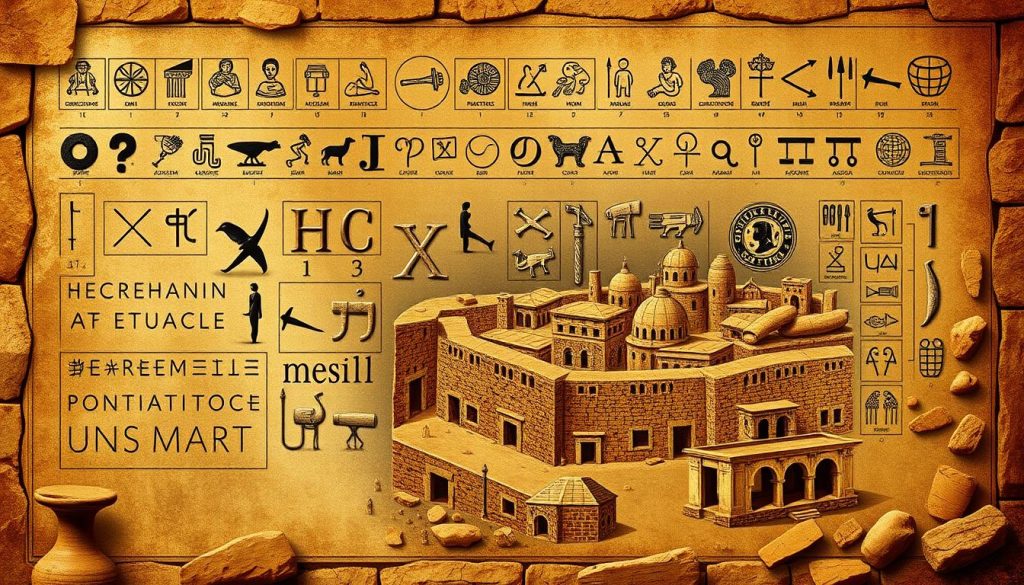The Etruscan Language: Deciphering a Dead Script.
The Etruscan language is a mystery from ancient times. It started in the seventh century B.C. and is unlike other languages from the Mediterranean. It’s a puzzle for scholars and historians.
Anúncios
Over 10,000 inscriptions have been found, giving us a peek into a civilization in what’s now Tuscany, Italy. The script came from the Euboean Greek alphabet. It shows a complex society before the Romans took over.
Research has uncovered interesting facts about this ancient script. It tells us about communication, trade, and society of a civilization that vanished under the Romans. Each text found adds to our understanding of this language.
Even though it died out by the first century CE, the Etruscan language is still important. It helps us understand the ancient Mediterranean world’s complex cultures.
Origins and Historical Context of the Ancient Etruscan Script
The Etruscan script is a key example of cultural exchange in the ancient world. It started around 700 BCE and shows how languages and cultures mix. It came from Euboean Greek traders who brought their writing to Italy.
Anúncios
The Etruscans took the Greek alphabet and made it their own. They changed it to fit their language better. This shows their skill in adapting to new ideas.
- Adopted from western Greek alphabets before 700 BCE
- Consisted of 26 unique signs
- Included symbols for four primary vowels
- Developed without initial word divisions
Studies show the Etruscan language was very different. It was related to only two other languages: Raetic and Lemnos. We have over 13,000 texts from this time, giving us a peek into their world.
| Characteristic | Detail |
|---|---|
| Total Inscriptions | Approximately 10,000 |
| Bilingual Inscriptions | Around 1,000 |
| Known Words | Approximately 200 |
“The Etruscan script represents a bridge between ancient cultural exchanges and linguistic evolution.”
The script shows the Etruscans’ advanced understanding of communication. Even though Latin became more common, Etruscan stayed important in formal and religious areas by the 1st century CE.
The Unique Features of Etruscan Writing System
The Etruscan writing system is a fascinating piece of ancient language. It has features that make it stand out from other scripts. The Etruscan alphabet shows how creative and different it was.
The script’s writing direction was unlike anything else. It went from right to left, unlike most scripts. This made Greek letters look reversed when Etruscans used them.
- Right-to-left writing orientation
- Reversed Greek letter adaptations
- Phonetic modifications unique to Etruscan sounds
The Etruscan alphabet shows great creativity. It started from the Phoenician alphabet but was changed to fit Etruscan needs. They added new signs and removed some consonants, making it perfect for their language.
The Etruscan script represents a sophisticated linguistic innovation that reflects the cultural complexity of this ancient civilization.
| Alphabet Characteristic | Unique Feature |
|---|---|
| Writing Direction | Predominantly Right-to-Left |
| Letter Adaptation | Greek Letters Reversed |
| Phonetic Modifications | Custom Consonant Adjustments |
Only Etruscan aristocrats knew about this advanced writing system. They used it on valuable items like mirrors and reels. This shows how much they valued written communication.
The Etruscan Language: Structure and Development

The Etruscan language is a puzzle for scholars. It has a unique structure and only a few texts left. It dates back to around 1,000 B.C. in Tuscany, Northern Italy. This ancient language is complex and its origins are still a mystery.
Studies show interesting facts about Etruscan language structure:
- Classified as a pre-Indo-European language
- Part of the Tyrsenian language family
- Related to Raetic and Lemnian languages
Despite few texts, researchers have made big strides in understanding Etruscan grammar. They have translated about 250 words. Scholars have worked hard for decades to uncover the language’s secrets.
The Etruscan alphabet stands as the earliest recorded Western script after Greek, adopted in the 8th century BC.
| Linguistic Characteristics | Research Insights |
|---|---|
| Total Known Words | Approximately 250 |
| Total Inscriptions | Around 13,000 (700 BC – AD 50) |
| Etymology Research | 97% of lexical items have Indo-European connections |
The development of Etruscan language is a story of cultural exchange. Genetic studies suggest continuity with Neolithic Italian farmers. This adds to the language’s rich history.
Even though it’s hard to fully understand, research keeps revealing the complex structure of this ancient language.
Surviving Inscriptions and Archaeological Evidence
Etruscan inscriptions offer a glimpse into an ancient world that has long fascinated scholars. Over 10,000 inscriptions from the 7th century BC have given us a deep look into Etruscan culture and how they communicated.
The evidence from archaeology shows the complexity of Etruscan writing. It reveals a rich world of communication through ancient artifacts. Key finds show the depth of their language:
- The Liber linteus Zagrabiensis, the longest surviving inscription, contains about 400 words from around 200 BC
- The Pyrgi gold tablets have bilingual inscriptions in Etruscan and Phoenician
- Most inscriptions are found in graves, giving us clues about their culture
Archaeological finds highlight the complexity of Etruscan writing:
| Inscription | Date | Word Count | Significance |
|---|---|---|---|
| Tabula Cortonensis | 200 BCE | 200 words | Bronze legal document |
| Cippo di Perugia | 3rd-2nd BCE | 128 words | Boundary inscription |
| Stele of Lemnos | 6th BCE | 33 words | Language relationship evidence |
“Each inscription is a puzzle piece revealing the intricate world of the Etruscan civilization.” – Archaeological Research Institute
The Etruscan alphabet, based on 19 Greek letters, shows their advanced communication. Despite a small vocabulary and simple grammar, these finds are key to understanding Etruscan life, laws, and cultural exchanges.
Religious and Funerary Uses of Etruscan Writing
The Etruscan civilization showed a deep link between writing, religion, and death rituals. Sacred inscriptions were key to understanding their spiritual views. They gave us a peek into a rich belief system that touched every part of life and death.
Etruscan religion was complex, with detailed rituals and symbols. Archaeology shows how they honored the dead with special tomb inscriptions and funerary items.
“The tomb was not an end, but a continuation of earthly existence” – Ancient Etruscan Belief
- Tombs often looked like homes
- They included personal items for the afterlife
- Inscriptions showed family ties and status
- Religious texts guided the spirit
The Etruscans created detailed sacred inscriptions that showed their complex beliefs. These writings told of rituals, divine talks, and spiritual views that were key to their culture.
| Funerary Practice | Significance |
|---|---|
| Tomb Decoration | Narrative of deceased’s life |
| Votive Offerings | Communication with deities |
| Ritual Inscriptions | Spiritual documentation |
Archaeology shows that about 80% of Etruscan texts were about death rituals. This highlights how important religious writing was to them. The Etrusca disciplina, though mostly lost, suggests a deep theological system that linked writing, ritual, and spiritual knowledge.
Practical Applications in Daily Life and Trade
Etruscan commerce was more than just trading. It was a complex network of economic interactions. They used inscribed objects to document their daily transactions and social exchanges.

Archaeological evidence shows how Etruscans used writing in their daily lives. Inscribed objects were key in recording commercial activities. They marked ownership, recorded prices, and documented transactions.
- Trade goods included iron, pottery, wine, and olive oil
- Merchants used inscriptions to track shipments
- Objects often carried detailed ownership marks
“Writing was not just communication, but a practical tool of commerce for the Etruscans”
The Etruscan trading system was complex and well-organized. They had extensive maritime trade routes across the Mediterranean. They traded goods with Greeks, Phoenicians, and other cultures.
| Trade Good | Export Region | Economic Significance |
|---|---|---|
| Bucchero Pottery | Mediterranean Basin | High Cultural Value |
| Wine | Tyrrhenian Sea | Primary Export Commodity |
| Iron | Near Eastern Markets | Strategic Resource |
Commerce was a big part of their daily life. Market days were planned around specific calendar cycles. The Etruscan society showed great economic sophistication through their trade and communication methods.
Mythological References and Divine Names
Etruscan mythology is a mix of cultures, blending local beliefs with Greek stories. The gods and goddesses of Etruscan lore show how languages and cultures change over time. This mix highlights the rich spiritual practices of the ancient Mediterranean.
The names of Etruscan gods show how flexible they were. Many gods were Etruscanized from Greek ones, leading to interesting changes in names:
- Aplu – Etruscan version of Apollo
- Ercle – Etruscan adaptation of Herakles
- Tinia – Etruscan equivalent of Zeus
- Turan – Etruscan representation of Aphrodite
Looking into Etruscan divine names, we find interesting patterns. About 37% of gods have Greek names, while 40% have unique Etruscan traits. The gods and goddesses cover a wide range of roles:
| Deity Category | Percentage | Example Names |
|---|---|---|
| Female Deities | 42% | Turan, Lasa Vecuvia, Thesan |
| War-related Deities | 22% | Laran, Selvans |
| Infernal Deities | 15% | Aita, Letham, Mani |
“The Etruscan pantheon represents a living, breathing cultural tapestry – not just a collection of names, but a reflection of complex spiritual interactions.” – Archaeological Research Quarterly
The Greek influence on Etruscan mythology is strong, with about 60% of gods sharing themes with Greek myths. This shows how ancient religions were open to new ideas, blending names and stories across cultures.
The Impact of Roman Expansion on Etruscan Language
The Roman expansion changed the language scene in ancient Italy. As Romans spread across the peninsula, Etruscan language started to fade. Cultural blending erased Etruscan’s unique language.
The shift in language happened in several stages:
- Initial bilingualism between Etruscan and Latin speakers
- Gradual social pressure to adopt Latin
- Increasing Roman political and cultural dominance
- Economic incentives favoring Latin communication
By the first century BCE, Etruscan language faced a lot of pressure. Linguistic studies suggest that language death typically occurs within three generations. This was true for Etruscan too.
“The last known Roman speaker of Etruscan was Emperor Claudius, who documented the language’s history in a 20-volume work,” highlighting its rapidly diminishing relevance.
Roman expansion led to a shift in languages. Most of Italia’s coins from that time were bilingual, showing Latin’s growing importance.
| Period | Linguistic Status |
|---|---|
| Early 1st Century BCE | Etruscan still widely spoken |
| Late 1st Century BCE | Significant language decline |
| 1st Century CE | Etruscan nearly extinct |
By Emperor Augustus’ time, Etruscan’s language was almost gone. It was fully absorbed into Roman culture.
Conclusion
The Etruscan language is a key part of ancient history, lasting about 500 years. It has over 10,000 known inscriptions. Scholars are still working to understand this language, which is crucial for preserving ancient cultures.
New technology, like AI, is changing how we study Etruscan language. It helps find patterns in old texts that we couldn’t see before. Words like “tus,” “laris,” and “zilath” give us a peek into Etruscan culture.
Even with big challenges, the drive to learn about Etruscan language keeps growing. Finds like the Zagreb mummy wrapping and the Pyrgi Lamellae are helping us understand Etruscan writing. These discoveries show us more about this civilization before the Romans took over.
The Etruscan legacy teaches us about the value of language and culture. As research goes on, we’ll learn more about this ancient people. Their stories will continue to inspire scholars and language lovers today.
